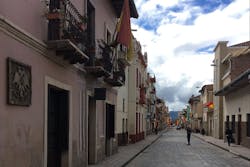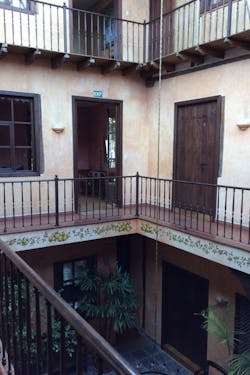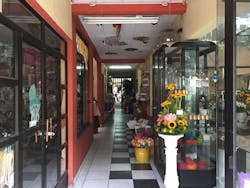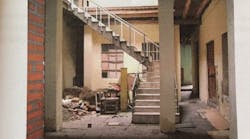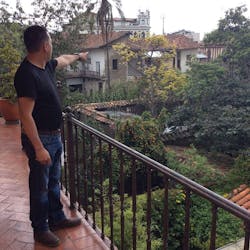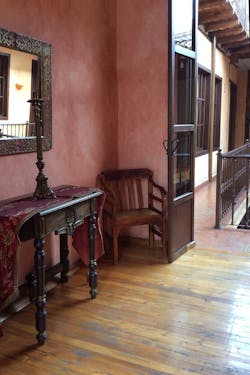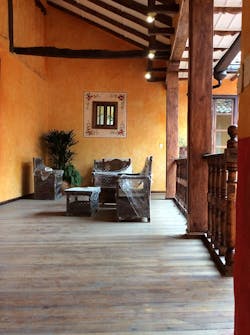El Aguila: A Love of Remodeling Turned A House Into A Hotel
As family size contracts, big houses become small hotels
You know you serve a good meal when diners snap pictures of it to share on social media. Somehow, the same must hold true for a remodeling job.
Here are a few postcards of one of my favorite architectural “meals,” the Casa del Aguila Hotel (and museum) in Cuenca, Ecuador.
But first, a little background.
When my wife and I travel, we like to stay at remodeled homes turned into bed and breakfasts, and Latin America offers many splendid homes-come-hotels. The reason why lies in demographics.
By comparison to the USA, Latino families remain significant, but they have shrunk by historical standards. Houses that used to accommodate two sets of grandparents, parents, aunts, uncles, and married kids with kids of their own, have too much space even for an average Latino family, consisting nowadays of a married couple, three children, and a mother-in-law.
The grand old houses of Latin America’s historical districts have become either hostels, or mini-malls with a courtyard at the center and boutiques, salons, and antique shops in the spaces that were once sewing rooms, ironing rooms, and bedrooms.
Some of the remodels of these old, colonial homes preserve the elegance and craft of the grand old manor house, and it’s impossible to resist the bite of the shutterbug – pictures, pictures, pictures.
Even as I write, early on a chilly Sunday morning at Casa del Aguila, sitting at an old cedar table atop at the cobblestone patio, surrounded by murals and beams, intricate wrought iron, delicately carved vigas draped with flowering bougainvillea, a tourist, in her own remodeling rapture, turns every which way snapping on her cellphone.
But at Casa del Aguila, it was not always this way. About eight years ago Jorge Gavilanes, a lawyer by training, and remodeler by passion brought back his grandmother’s ancestral home. For decades, it had rotted in place, owned by an absentee slumlord that allowed as many as 60 people to occupy the main house.
The condition of the home, eight years ago, was so rundown that the property sold as land, and not as a structure. Gavilanes felt compelled to undertake the rehab and remodeling of the home, despite the city’s order to tear it down.
Only later, as worked progressed, did someone suggest he turn it into a small hotel, and the idea took hold. The initial impulse was to restore and repair it only as a family heirloom, not capitalize on it. Nonetheless, thanks to this decision, now many people come and enjoy the results of Gavilanes’ passion for historical restoration, and Gavilanes has moved on to other projects.
The renovation took two years, involved many family members doing the restoration work, which included restoring a private wing, adjacent to the hotel, where Grandma still lives. She has no role in running the hotel but guides all of the remodeling work.
In every detail, Gavilanes’ grandmother, still alive, serves as chief architect, since she remembers how things were and hence how they should be.
Typical of bureaucracy, now fully restored, the house the city fathers wanted Gavilanes to tear down has become a historical monument, and he cannot even remove a nail without a special permit. The irony does not escape Gavilanes; however, he has purchased other bits and pieces of the family estate, slowly reconstructing the patrimony.
He took us around the corner to see a second hotel built out of smaller homes, and down the block to see a project underway, where he and his cousin Fausto Merchán are converting a grand house into about five apartments.
As Jorge Gavilanes realized how much people loved the authentically remodeled old home that became a hotel, he bought other properties to do the same.
His sister runs another rehabilitated hotel about a block away, and with a cousin, Gavilanes is remodeling a manor home nearby into rental apartments for retired Americans that flock to Cuenca for its walkable charms, cultural assets, and low-cost living.
Fausto Merchán, a painter and muralist, remains a significant contributor to Gavilanes’ remodeling projects, as the artist responsible for all the images on both plaster and canvas.A great remodel comes from care for details. When you can look anywhere and find something beautiful to stare at, and pictures of, you have succeeded in creating a place that brings contentment.
What follows is a tour of some—certainly, not all—of the extraordinary details that Gavilanes painstakingly preserved in the ancestral home that is now the Aguila Hotel—a bed and breakfast.
— Fernando Pagés Ruiz is ProTradeCraft's Latin America Editor. He is currently building a business in Ecuador and a house in Mexico. Formerly a builder in the Great Plains and the Mountain States, Fernando is also the author of Building an Affordable House and Affordable Remodel (Taunton Press).
About the Author
Fernando Pagés Ruiz
Fernando Pagés Ruiz is ProTradeCraft's Latin America Editor. He is currently building a business in Ecuador and a house in Mexico. Formerly, he was a builder in the Great Plains and Mountain States. He is author of Building an Affordable House and Affordable Remodel (Taunton Press).

